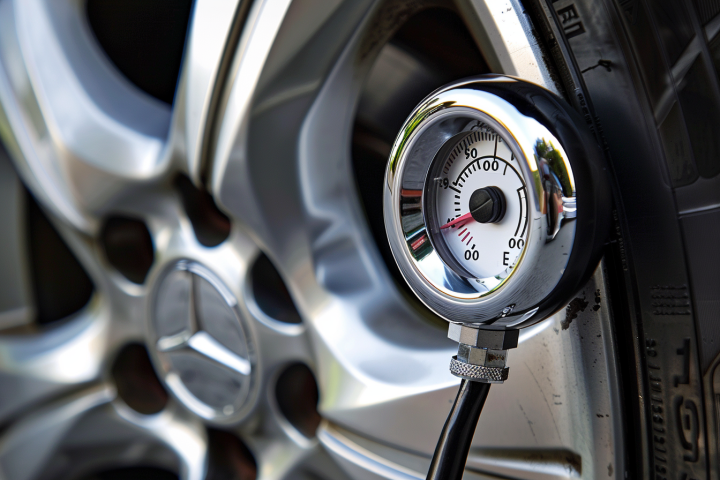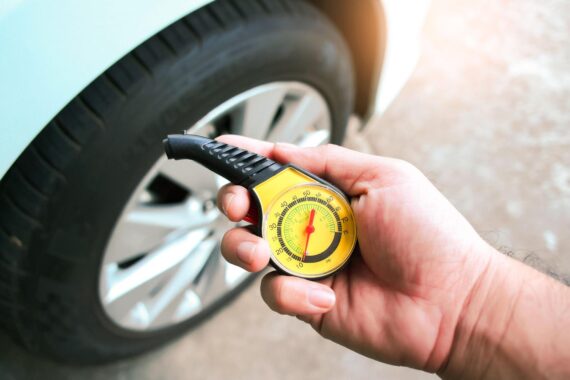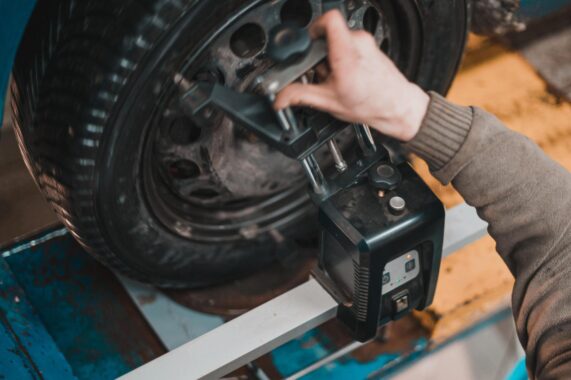Last Updated on 2 weeks
Unveiled TPMS Sensors
Tire Pressure Monitoring Systems (TPMS) have emerged as a vital component of modern vehicles, fundamentally changing how we approach tire maintenance and safety. In this comprehensive exploration, we delve into the value and benefits of TPMS sensors, beginning with a close examination of TPMS technology. In this exploration, we will delve into the core functionalities of Tire Pressure Monitoring Systems (TPMS), examining the various sensor types and contrasting them with conventional tire pressure monitoring practices. Through this analysis, we shall establish TPMS sensors’ critical role in guaranteeing optimal vehicle safety, fuel efficiency, and extended tire lifespan.
The Essence of TPMS Technology
Tire Pressure Monitoring Systems (TPMS) have revolutionized monitoring and maintaining vehicle tire pressure. This technology is at the core of ensuring tire safety, efficiency, and longevity. TPMS sensors are designed to continuously monitor the air pressure within each tire and provide real-time data to the driver.
The essence of TPMS technology lies in its ability to prevent dangerous situations caused by underinflated or overinflated tires. Sensors measure the air pressure and temperature inside each tire, transmitting this information to the vehicle’s onboard computer. The System then alerts the driver if tire pressure falls below or exceeds the recommended levels.
Different Types of TPMS Sensors
There are two main types of TPMS sensors: direct and indirect.
Direct TPMS Sensors:
Direct TPMS sensors are modern vehicles’ most common and accurate sensors. These sensors are mounted on each tire’s valve stem or inside the tire itself. They directly measure the tire’s air pressure and temperature and transmit this information wirelessly to the vehicle’s computer. Direct TPMS sensors provide real-time data and are known for their precision.

Indirect TPMS Sensors:
Indirect TPMS sensors, on the other hand, do not measure air pressure directly. Instead, they rely on the vehicle’s onboard sensors to detect changes in tire size, wheel speed, and other parameters that may indicate tire pressure abnormalities. While indirect TPMS sensors are less expensive to install, they are generally less accurate than their direct counterparts.
TPMS Sensors vs. Traditional Methods
Before the widespread adoption of TPMS technology, monitoring tire pressure relied on manual methods, such as visual inspections and pressure gauges. Let’s explore how TPMS sensors compare to these traditional methods:
Accuracy:
TPMS sensors offer unparalleled accuracy, providing real-time tire pressure and temperature data. Traditional methods, such as visual inspections or using a pressure gauge, are less precise and can easily miss subtle pressure changes.
Convenience:
TPMS sensors work continuously, requiring no manual intervention. Drivers are instantly alerted to tire pressure issues, allowing prompt action. In contrast, traditional methods necessitate regular, manual checks, often neglected, leading to potential safety hazards.
Safety:
TPMS sensors significantly enhance safety by proactively warning drivers about tire pressure abnormalities. This early detection reduces the risk of accidents due to blowouts or loss of control. Traditional methods rely on drivers noticing signs of underinflated tires, which may be too late to prevent accidents.
Tire Lifespan:
Properly inflated tires have a longer lifespan, and TPMS sensors help ensure optimal tire pressure. Traditional methods may result in uneven tire wear and reduced longevity.
TPMS sensors have revolutionized tire pressure monitoring, offering accuracy, convenience, safety, and enhanced tire lifespan compared to traditional methods. Understanding the essence of TPMS technology and the different types of sensors is essential for evaluating their value and benefits in maintaining vehicle safety and efficiency.
The Cost-Benefit Analysis
A crucial aspect of Tire Pressure Monitoring Systems (TPMS) adoption lies in cost-benefit analysis. This article explores the financial considerations of TPMS sensors, including upfront costs, potential savings on fuel and tire replacements, and achieving a balance between safety enhancement and budgetary constraints.
TPMS Sensors: An Investment or an Expense?
Tire Pressure Monitoring Systems (TPMS) sensors can be viewed as an added expense. Let’s explore their role in enhancing safety and weigh it against the initial cost.
- Safety Enhancement: TPMS sensors play a pivotal role in maintaining proper tire pressure, which is directly linked to vehicle safety. By preventing underinflated or overinflated tires, TPMS sensors reduce the risk of accidents, blowouts, and loss of vehicle control. This safety enhancement can ultimately save lives and prevent property damage.
- Long-Term Savings: While installing TPMS sensors involves an initial cost, the long-term savings in terms of reduced fuel consumption, extended tire lifespan, and avoidance of costly repairs can outweigh the initial investment.
- Regulatory Compliance: In many regions, TPMS sensors are mandatory for specific vehicles to comply with safety regulations. Non-compliance can lead to fines and penalties, making TPMS sensors a necessary expense for legal reasons.
- Resale Value: Equipping your vehicle with TPMS sensors can also positively impact its value. Buyers often prioritize safety features; a TPMS-equipped vehicle may fetch a higher price on the used market.
Calculating the Potential Savings
To determine the potential savings associated with TPMS sensors, it is essential to consider the following factors:
- Fuel Efficiency: Properly inflated tires result in improved fuel efficiency. TPMS sensors help maintain optimal tire pressure, which can lead to noticeable savings in fuel costs over time.
- Tire Lifespan: Underinflated or overinflated tires wear out faster and require more frequent replacements. TPMS sensors can extend the lifespan of your tires, reducing the frequency of tire replacements and associated costs.
- Repair and Maintenance Costs: TPMS sensors help detect tire issues early, preventing more extensive and expensive repairs down the road. This includes avoiding tire blowouts, which can lead to costly vehicle damage.
- Safety-Related Costs: Accidents caused by tire issues can result in significant medical bills, property damage, and increased insurance premiums. TPMS sensors contribute to accident prevention, potentially saving you from these financial burdens.
Balancing Safety and Budget
Balancing safety and budget considerations is a crucial aspect of the cost-benefit analysis. To strike the right balance, consider the following tips:
- Evaluate Your Needs: Assess your specific driving habits, the type of vehicle you own, and the prevailing safety regulations in your area to determine the necessity of TPMS sensors.
- Explore Options: Research different TPMS sensor models and their price ranges. Choose a system that aligns with your budget while meeting your safety requirements.
- Long-Term Perspective: Remember that TPMS sensors offer long-term benefits. While the upfront cost may seem significant, consider the potential savings and safety enhancements over the life of your vehicle.
- Professional Installation: Ensure qualified professionals install TPMS sensors to avoid issues and maximize their effectiveness.
TPMS sensors should be viewed as an investment in safety and long-term cost savings rather than a mere expense.
Enhanced Safety Through TPMS
Tire Pressure Monitoring Systems (TPMS) have become a cornerstone of automotive safety technology. This article explores how TPMS contributes to a safer driving experience by examining its real-time monitoring capabilities, its role in preventing accidents, and its ability to mitigate the risks associated with tire blowouts.
Real-Time Tire Pressure Monitoring
One of the primary functions of TPMS is to provide real-time tire pressure monitoring, allowing drivers to stay informed about the condition of their tires while on the road. This aspect of TPMS safety includes the following key points:
- Continuous Monitoring: TPMS sensors continuously measure the air pressure inside each tire. This information is relayed to the vehicle’s computer system, ensuring drivers can access up-to-the-second data on tire pressure.
- Visual Warnings: When tire pressure levels deviate from the recommended levels, TPMS systems immediately alert the driver through visual warnings on the dashboard. This allows for prompt action to address any issues.
- Audible Alerts: In addition to visual warnings, TPMS sensors may also provide audible alerts, such as a chime or beep, to ensure that drivers are aware of the tire pressure anomaly.
- Instant Response: Real-time monitoring means that drivers can take immediate corrective actions, such as inflating underinflated tires, thereby reducing the risk of tire-related accidents.
The Role of TPMS in Accident Prevention
TPMS plays a crucial role in preventing accidents on the road by addressing the following safety considerations:
- Stability and Control: Properly inflated tires maintain the vehicle’s stability and control. Underinflated tires, on the other hand, can reduce handling capabilities, increasing the likelihood of accidents, especially during emergency maneuvers.
- Reduced Risk of Hydroplaning: Adequate tire pressure helps prevent hydroplaning on wet roads. TPMS sensors assist in maintaining the optimal tire pressure, reducing the risk of accidents due to loss of traction in moist conditions.
- Braking Efficiency: Properly inflated tires improve braking efficiency. TPMS ensures that tires are adequately inflated, allowing for shorter braking distances and reducing the chances of rear-end collisions.
- Avoiding Tire-Related Accidents: Tire blowouts and failures can lead to catastrophic accidents. TPMS sensors provide early warnings of potential tire issues, enabling drivers to take preventive action before a blowout occurs.
Avoiding Blowouts and Emergencies
One of the most dangerous situations on the road is a sudden tire blowout, which can lead to loss of control and severe accidents. TPMS contributes to avoiding blowouts and emergencies in the following ways:
- Early Detection: TPMS sensors can detect gradual pressure loss or sudden drops in pressure, allowing drivers to address issues before they escalate into emergencies.
- Maintaining Optimal Pressure: TPMS sensors help maintain optimal tire pressure by continuously monitoring tire pressure. This reduces the risk of overinflation, which can also lead to blowouts.
- Minimizing Risk: Blowouts often result in accidents, particularly at high speeds. TPMS reduces this risk by providing advanced warning, giving drivers time to pull over safely.
- Emergency Preparedness: TPMS equips drivers with crucial information during emergencies, enabling them to make informed decisions to protect themselves and others on the road.
TPMS plays a vital role in enhancing road safety by monitoring real-time tire pressure, preventing accidents, and avoiding potentially catastrophic tire blowouts and emergencies. The continuous monitoring and early warnings offered by TPMS systems empower drivers to maintain safer driving conditions and make informed decisions, ultimately contributing to safer roads.

Longevity and Efficiency
Tire Pressure Monitoring Systems (TPMS) offer more than just safety benefits; they also contribute significantly to the longevity and efficiency of your vehicle’s tires and overall performance. This article will explore how TPMS prolongs tire lifespan, enhance fuel efficiency, and even address environmental impact considerations.
Prolonging Tire Lifespan with TPMS
Prolonging the lifespan of your vehicle’s tires is cost-effective and environmentally friendly. TPMS sensors play a crucial role in achieving this goal by:
- Optimal Tire Pressure: TPMS continuously monitors tire pressure and alerts drivers when it falls below or exceeds recommended levels. Properly inflated tires experience less wear and tear, extending lifespan.
- Even Tire Wear: Maintaining consistent tire pressure ensures tires wear evenly across the tread. Uneven wear can result from underinflation or overinflation and may necessitate premature tire replacement.
- Avoiding Overloading: TPMS sensors can also help drivers avoid overloading their vehicles. Overloading can strain tires and lead to quicker degradation.
- Precise Tire Maintenance: TPMS warns drivers of low pressure and facilitates timely maintenance. Regular maintenance, such as tire rotation and alignment, can extend tire lifespan.
Fuel Efficiency Gains and Cost Reduction
Enhancing fuel efficiency is a crucial benefit of TPMS, and it leads to cost reduction in several ways:
- Reduced Rolling Resistance: Properly inflated tires reduce rolling resistance, which is the force that opposes tire movement. Lower rolling resistance translates to improved fuel efficiency, as the engine doesn’t have to work as hard to move the vehicle.
- Optimal Fuel Combustion: Maintaining recommended tire pressure levels ensures that tires provide the ideal traction and grip. This results in smoother and more efficient fuel combustion, reducing fuel consumption.
- Longer Tread Life: TPMS sensors help extend the tread life of tires, meaning you won’t need to replace them as often. This leads to cost savings not only in fuel but also in tire replacement expenses.
- Environmental Benefits: Improved fuel efficiency translates to reduced carbon emissions, making TPMS a green technology that contributes to environmental sustainability.
Environmental Impact Considerations
Environmental considerations are increasingly important in today’s world. TPMS contributes to a greener environment in various ways:
- Reduced Carbon Emissions: Vehicles with properly inflated tires produce fewer carbon emissions because the engine operates more efficiently. TPMS helps lower fuel consumption and, consequently, reduces the environmental footprint.
- Less Tire Waste: Proper tire maintenance and inflation extend tire lifespans, which means fewer tires end up in landfills. Tire disposal is a significant environmental concern due to its non-biodegradable nature.
- Resource Conservation: Prolonging tire lifespan means fewer raw materials are required to manufacture new tires. This conserves natural resources and reduces the energy-intensive process of tire production.
- Regulatory Compliance: Some regions have environmental regulations that mandate using TPMS as part of broader efforts to reduce emissions and minimize environmental impact.
TPMS sensors offer safety benefits and contribute to tire longevity and efficiency, leading to cost reduction and environmental benefits. By maintaining optimal tire pressure, TPMS promotes even tire wear, enhances fuel efficiency, and reduces carbon emissions. It is a technology that aligns with sustainability goals and responsible vehicle ownership in the modern world.
Navigating TPMS Regulations
Tire Pressure Monitoring Systems (TPMS) have transcended their role as a safety feature and have become a mandated technology in many regions. This article delves into the complexities of TPMS regulations, including variations based on vehicle types, potential consequences for non-compliance, and strategies for staying informed as these regulations evolve.
TPMS Mandates for Different Vehicles
Regulations surrounding TPMS are designed to enhance safety and are typically categorized by vehicle type:
- Passenger Vehicles: In many countries, including the United States, TPMS has been mandated for all new passenger vehicles manufactured after a specific date. The exact dates and requirements may vary by region, so manufacturers and consumers must stay informed about local regulations.
- Light Trucks and SUVs: Similar to passenger vehicles, light trucks and SUVs are often subject to TPMS mandates. These regulations aim to ensure that all vehicles, regardless of size or type, benefit from the safety advantages of TPMS.
- Commercial Vehicles: Many regions have extended TPMS mandates to commercial vehicles, including trucks, buses, and vans. These regulations are intended to reduce the risk of tire-related accidents involving larger vehicles that can have more significant consequences.
- Trailers: In some cases, trailers may also be subject to TPMS mandates, mainly if they are used for commercial purposes or exceed specific weight thresholds.
Consequences Of Non-Compliance
Non-compliance with TPMS regulations can have serious consequences, including:
- Fines and Penalties: Regulatory agencies often impose fines and penalties on manufacturers, dealerships, or vehicle owners who fail to adhere to TPMS mandates. These fines can be substantial, depending on the jurisdiction and the severity of the violation.
- Recall Orders: Non-compliance may lead to recall orders for vehicles not meeting TPMS requirements. Manufacturers may be required to retrofit or upgrade vehicles at their expense to meet the regulations.
- Insurance Implications: In some cases, non-compliance with safety regulations, including TPMS mandates, may affect insurance coverage. An accident involving a non-compliant vehicle could result in denied insurance claims or higher premiums.
- Liability Concerns: Vehicle owners who neglect TPMS regulations may face liability issues if an accident occurs due to tire-related issues. Courts may find them negligent for not complying with safety standards.
Staying Ahead of Regulatory Changes
To navigate TPMS regulations effectively and ensure compliance, consider the following strategies:
- Regularly Check Local Regulations: Stay informed about TPMS mandates in your region and any updates or changes to the requirements. Regulatory agencies often publish information online, and manufacturers provide vehicle compliance details.
- Consult Manufacturers: Vehicle manufacturers are responsible for ensuring compliance with TPMS regulations for their products. Contacting the manufacturer or dealership can provide specific information about your vehicle’s compliance status.
- Maintain and Update TPMS Systems: If your vehicle is equipped with TPMS, ensure it is properly maintained and functioning. Outdated or malfunctioning TPMS systems may lead to compliance issues.
- Proactive Compliance: If you own a fleet of vehicles, whether commercial or personal, consider proactive compliance measures, including retrofitting TPMS systems if necessary.
- Professional Assistance: When in doubt about TPMS regulations or compliance, consult with automotive industry professionals or regulatory agencies for guidance.
Implementing TPMS Effectively
TPMS are valuable tools for enhancing vehicle safety and efficiency, but their effectiveness relies on proper installation, maintenance, and calibration. This article will provide a comprehensive guide to implementing TPMS effectively, including a step-by-step installation guide, routine maintenance tips, and troubleshooting and calibration techniques.
Step-by-Step Installation Guide
Proper installation is the foundation of effective TPMS operation. Follow these steps for a successful installation:
- Gather Necessary Tools: Collect the tools and materials required for the installation, including the TPMS sensor kit, a jack, a lug wrench, and any additional components specified in the manufacturer’s instructions.
- Consult the Manual: Read the manufacturer’s installation manual carefully. The manual will provide specific instructions for your TPMS sensor model and vehicle type.
- Locate Valve Stems: Identify the valve stems on each tire where the TPMS sensors will be installed. Ensure that the valve stems are clean and free of debris.
- Install Sensors: Carefully attach the TPMS sensors to the valve stems following the manufacturer’s guidelines. Use the appropriate torque specifications to avoid over-tightening, which can damage the sensors.
- Secure the Sensors: Secure the sensors to the valve stems using the provided hardware once installed. Ensure a snug fit to prevent sensor movement.
- Activate Sensors: After sensor installation, activate them according to the manufacturer’s instructions. Activation typically involves driving the vehicle for a set distance or using a specific tool to initiate communication between the sensors and the vehicle’s onboard computer.
- Verify Functionality: Confirm that the TPMS system functions correctly by checking for tire pressure readings on the dashboard display or TPMS monitor.
- Reset the System (if required): If the TPMS system needs a reset, follow the instructions to clear any previous sensor data and establish new baseline readings.
Routine Maintenance Tips
Maintaining your TPMS system is crucial for accurate and reliable performance:
- Regularly Check Tire Pressure: Perform routine tire pressure checks using a reliable gauge. Adjust the tire pressure as needed to match the manufacturer’s recommendations and maintain the correct levels.
- Inspect Sensor Batteries: TPMS sensors are battery-powered. Periodically check the battery status to ensure they are functioning correctly. Replace batteries according to the manufacturer’s guidelines.
- Clean Sensors: Keep the sensors clean from dirt, debris, and road salt, as these can interfere with sensor performance. Gently wipe the sensors during routine tire maintenance.
- Verify Calibration: If experiencing TPMS warnings or abnormal readings, it may be necessary to recalibrate the System. Consult the manufacturer’s instructions or seek professional assistance.
Troubleshooting and Calibration
Troubleshooting and calibration are essential for resolving TPMS issues:
- Interpreting Warning Lights: Be familiar with the TPMS warning lights on your dashboard. Different patterns or colors may indicate low tire pressure, sensor malfunctions, or communication errors.
- Addressing Warning Alerts: Take immediate action when a TPMS warning alert occurs. Check tire pressures, inspect for damage or leaks, and address any issues promptly to avoid potential safety risks.
- Professional Calibration: When you need TPMS calibration or troubleshooting, it is highly recommended that you consult a qualified technician or visit a TPMS-equipped service center. Professional attention ensures accurate system function and optimal safety.
Choosing the Right TPMS System
Selecting the right TPMS system for the vehicle ensures optimal performance. This comprehensive guide empowers you to make informed decisions when choosing a Tire Pressure Monitoring System (TPMS). It explores the key factors to consider for your specific car, delves into the offerings of leading TPMS brands and models, and provides insights on customizing the System to suit your needs best.
Factors to Evaluate for Your Vehicle
When choosing a TPMS system, consider the following factors tailored to your vehicle’s needs:
- Vehicle Type: Different vehicles, such as passenger cars, trucks, SUVs, and motorcycles, may have unique TPMS requirements. Ensure that your TPMS system is compatible with the vehicle type.
- Tire Quantity: Determine the vehicle’s number of tires. Some TPMS systems are designed for four-tire cars, while others accommodate more wheels, such as those on larger trucks or trailers.
- Sensor Type: Evaluate your preference for direct or indirect TPMS sensors. Direct sensors offer real-time tire pressure and temperature monitoring and are typically more accurate. Indirect systems rely on vehicle data and could be more precise.
- Display Type: The display unit is crucial when selecting a TPMS system. Dedicated TPMS displays offer a wider range of information, allowing for detailed pressure readings and potentially additional features. Conversely, integrated systems utilize your vehicle’s existing dashboard display, maintaining a clean aesthetic but potentially limiting the amount of visible data.
- Battery Life: Examine the expected battery life of the TPMS sensors. Longer-lasting batteries mean less frequent sensor replacements and maintenance.
- Ease of Installation: Evaluate the installation process. Some TPMS systems require professional installation, while others offer straightforward DIY options.
- User-Friendliness: Check the user interface of the TPMS system. User-friendly displays and controls make monitoring tire pressure and troubleshooting issues more accessible.
Top Brands and Models in the Market
Several reputable brands and models offer reliable TPMS systems:
- Schwinn TPMS: Schwinn provides a range of TPMS systems known for their accuracy and ease of use. Their sensors are compatible with various vehicle types and come with user-friendly displays.
- TST (Truck System Technologies) TPMS: TST specializes in TPMS solutions for larger vehicles, such as trucks, RVs, and trailers. They provide accurate and robust systems designed to withstand the rigors of heavy-duty use.
- Bartec TPMS: Bartec is a well-known name in the TPMS industry. It offers various products catering to different vehicle types and needs. Bartec is known for its precise and reliable sensors.
- Dorman TPMS: Dorman TPMS systems are known for their affordability and reliability. They provide a range of options suitable for passenger cars and light trucks.
- Schrader TPMS: Schrader pioneered TPMS technology and offers many TPMS sensors and tools. They are known for their high-quality sensors and accuracy.
Customizing TPMS for Your Needs
Customization options for TPMS systems allow you to tailor the System to your specific requirements:
- Additional Sensors: If the vehicle has more wheels than a standard four-tire setup, consider purchasing other sensors to ensure comprehensive monitoring.
- Display Preferences: When choosing a TPMS system, consider the display unit. Dedicated TPMS units offer extensive information and customizable features while integrated systems seamlessly utilize your existing dashboard display. Select the display type that best suits your preference for information detail and overall aesthetics.
- Alert Thresholds: Customize the alert thresholds for tire pressure and temperature according to your driving conditions and preferences.
- Advanced Features: Check TPMS systems with advanced features, such as smartphone connectivity, Bluetooth compatibility, or remote monitoring options, for added convenience and functionality.
- Integration with Other Systems: Some TPMS systems can integrate with other vehicle monitoring systems, providing a comprehensive overview of the vehicle’s condition.
We delve into real-life case studies that showcase the practical benefits and success stories of implementing Tire Pressure Monitoring Systems (TPMS). By examining these cases, we gain valuable insights into the tangible advantages of TPMS in various applications, the quantifiable safety improvements achieved, and how to measure the Return on Investment (ROI) of TPMS.
Success Stories in Various Applications
TPMS systems have proven their worth in various applications, each with unique challenges and requirements. Here are some success stories from multiple fields:
- Commercial Trucking: Trucking companies have reported significant safety improvements and cost savings after adopting TPMS. Reduced accident rates, lower maintenance costs, and extended tire lifespans are common success indicators.
- Fleet Management: TPMS has improved vehicle reliability, on-time deliveries, and fuel efficiency for fleet operators. Real-time monitoring and immediate alerts enable proactive maintenance and reduce unexpected breakdowns.
- Passenger Vehicles: TPMS has enhanced passenger car safety by preventing accidents due to tire-related issues. Drivers have reported feeling more confident and in control with TPMS-equipped vehicles.
- Off-Roading: TPMS is increasingly popular among off-road enthusiasts. It helps maintain tire pressure levels suitable for different terrains, optimizes traction, and reduces the risk of punctures.
- Recreational Vehicles (RVs): RV owners have experienced more enjoyable and safer travels with TPMS. They benefit from monitoring the tires of their vehicles, trailers, and towed vehicles.
Quantifying Safety Improvements
Measuring the safety improvements achieved through TPMS implementation involves considering various metrics:
- Accident Reduction: Many case studies reveal a substantial decrease in accidents related to tire issues after TPMS adoption. These accidents often result in injuries, fatalities, and property damage, making accident reduction a crucial safety metric.
- Tire Blowout Prevention: TPMS systems help prevent dangerous tire blowouts, which can lead to vehicle rollovers and severe accidents. By eliminating blowouts, TPMS significantly enhances road safety.
- Control and Handling: Properly inflated tires improve vehicle stability and control, especially in emergencies. Drivers report feeling more in control and better able to respond to unexpected events.
- Tire-Related Incidents: Monitoring tire pressure in real-time allows drivers to address minor issues, such as slow leaks, before they become significant problems. This proactive approach reduces the likelihood of tire-related incidents on the road.
Measuring the ROI
Calculating the Return on Investment (ROI) of TPMS involves assessing both cost savings and revenue improvements:
- Cost Savings: TPMS contributes to cost savings through reduced fuel consumption, extended tire lifespans, lower maintenance and repair costs, and fewer accidents and associated expenses.
- Revenue Enhancement: TPMS can improve revenue for businesses by minimizing vehicle downtime, ensuring timely deliveries, and enhancing the fleet’s overall reputation and reliability.
- Reduced Liabilities: By preventing accidents and blowouts, TPMS minimizes the potential for costly liability claims and legal expenses.
- Insurance Premiums: Some insurance providers offer discounts for vehicles equipped with TPMS due to their enhanced safety features, resulting in lower insurance premiums.

Conclusion & Recommendations
We conclude our comprehensive guide on Tire Pressure Monitoring Systems (TPMS) with a summary of the benefits and costs associated with TPMS. We’ll also provide essential recommendations to help you make an informed decision about incorporating TPMS into your vehicle. Ensuring your vehicle’s safety and performance is a top priority, and TPMS plays a pivotal role in achieving that goal.
Making an Informed Decision
Throughout this guide, we have checked the numerous advantages of TPMS, from enhanced safety and efficiency to extended tire lifespan and reduced maintenance expenses. Let’s summarize the key benefits and costs of TPMS:
- Safety: TPMS significantly improves road safety by preventing accidents, blowouts, and accidents related to tire issues. It provides real-time monitoring, immediate alerts, and enhanced vehicle control.
- Efficiency: TPMS contributes to fuel efficiency gains by maintaining optimal tire pressure levels. This leads to reduced fuel consumption, lower carbon emissions, and long-term cost savings.
- Tire Lifespan: Proper tire pressure extends the lifespan of your tires, reducing the frequency of replacements and saving you money in the long run.
- Cost Reduction: TPMS helps lower maintenance and repair costs by addressing tire-related issues before they become significant problems. It also reduces the risk of accidents and associated expenses.
- Environmental Impact: TPMS aids in minimizing carbon emissions and conserving natural resources by promoting proper tire maintenance and efficient fuel consumption.
However, the initial investment in TPMS, which includes the cost of sensors, installation, and potential ongoing maintenance, must be considered.
Taking Action for Improved Vehicle Safety
After a comprehensive understanding of TPMS and its benefits, it is time to take action for improved vehicle safety. Here are some key recommendations:
- Evaluate Your Vehicle: Determine whether the vehicle is TPMS-equipped or requires an aftermarket TPMS system. Consider the specific needs, vehicle type, and budget.
- Research TPMS Systems: Explore the available TPMS systems, considering factors such as sensor type, display preferences, and additional features. Look for reputable brands and models.
- Professional Installation: Opt for professional installation to calibrate the TPMS system.
- Regular Maintenance: Commit to regular tire maintenance, including checking tire pressure, inspecting for damage, and replacing sensors as needed. This proactive approach maximizes the benefits of TPMS.
- Stay Informed: Stay up-to-date with TPMS regulations within the region and any advancements in TPMS technology. Being informed allows you to make informed decisions about your vehicle’s safety.
- Monitor and Respond: Pay attention to TPMS alerts and warnings. Act promptly when alerted to low tire pressure or other issues to maintain vehicle safety.
Ready to Ensure Your Vehicle’s Safety?
Please take the next step towards improved vehicle safety by exploring our wide selection of tires at Giga Tires. We offer a range of tire options to suit your vehicle’s needs, and our experienced team is ready to assist you. Don’t compromise on safety; invest in high-quality tires from Giga Tires today.
Your safety is our priority, and we look forward to helping you choose the right tires for your vehicle.
FAQs
What is a TPMS light sensor?
A TPMS light sensor is the indicator light on a vehicle’s dashboard that illuminates when the TPMS system detects abnormal tire pressure or other tire-related issues. It alerts the driver to take necessary action, such as checking tire pressure or addressing potential problems.
What is a TPMS sensor valve?
A TPMS sensor valve is a component of the TPMS sensor that attaches to the tire’s valve stem. It contains the pressure and temperature sensors and the electronics necessary to transmit data to the vehicle’s onboard computer.
What is a TPMS sensor tool?
A TPMS sensor tool is a handheld device for various TPMS-related tasks, such as sensor activation, programming, calibration, and troubleshooting. It helps ensure proper sensor function and tire pressure accuracy.
Do you need TPMS sensors?
TPMS sensors are essential for real-time tire pressure monitoring, enhancing safety, and preventing accidents due to underinflated or overinflated tires.
Is TPMS expensive?
While there is an initial cost for TPMS installation, the long-term benefits, including improved fuel efficiency, extended tire lifespan, and reduced maintenance expenses, often outweigh the upfront expense.
Is there a cost benefit to using a TPMS system?
Yes, there is a significant cost benefit to using a TPMS system. It helps reduce fuel consumption, prevent costly tire-related accidents, lower maintenance and repair expenses, and extend tire lifespans.
Is replacing the TPMS sensors worth it?
It is worth replacing TPMS sensors when they malfunction or batteries die. Properly functioning sensors are crucial for accurate tire pressure monitoring and vehicle safety.
Is it necessary to have TPMS sensors?
While not mandatory for all vehicles, TPMS sensors are highly recommended for improved safety, fuel efficiency, and tire maintenance. Many regions have regulations requiring TPMS for new cars.
What is the power source of direct TPMS?
Direct TPMS sensors, which provide real-time tire pressure data, are powered by internal batteries. These batteries typically have a lifespan of 5-10 years, after which sensor replacement may be necessary.










